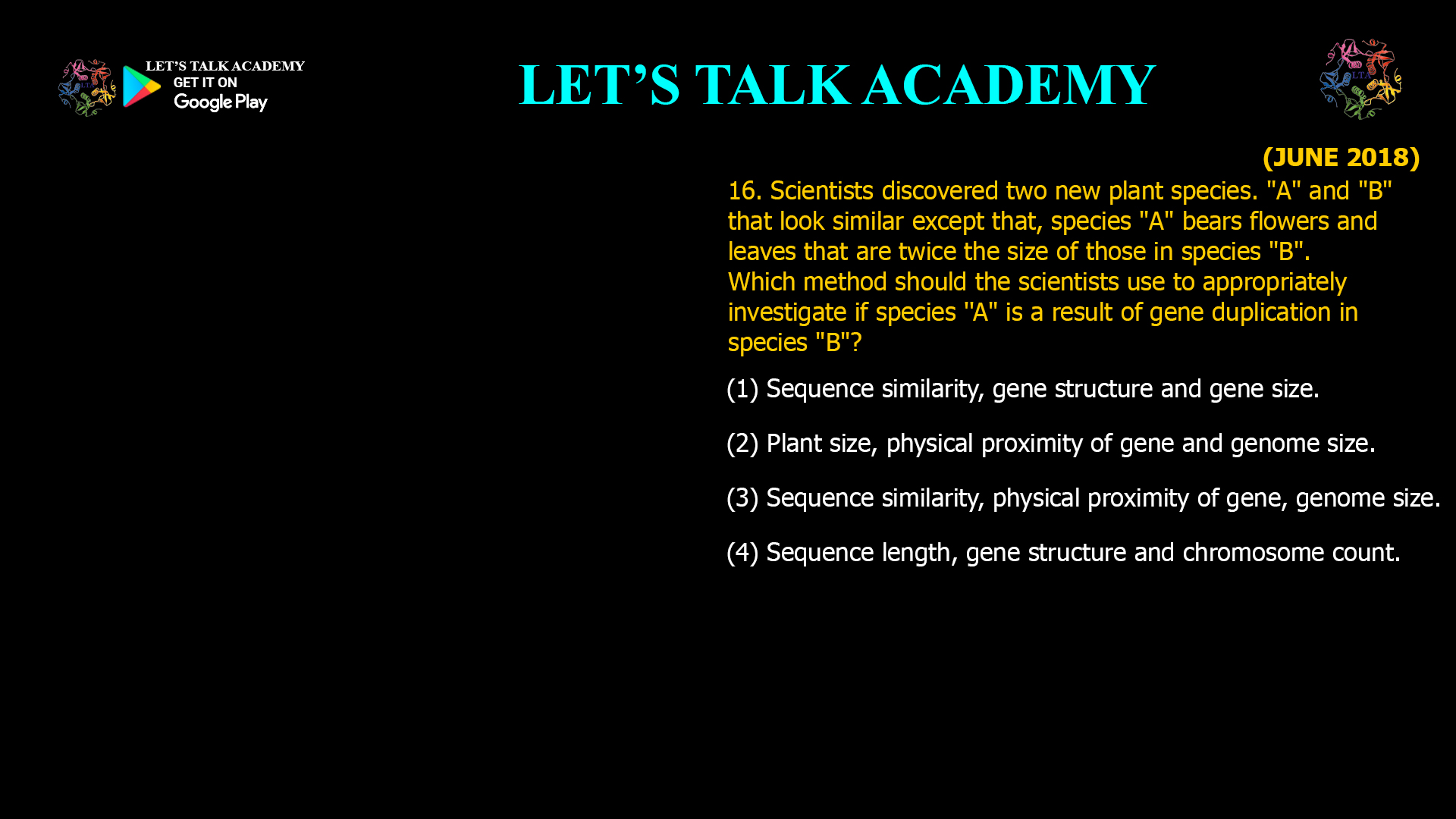- Scientists discovered two new plant species. “A” and “B” that look similar except that, species “A” bears flowers and leaves that are twice the size of those in species “B”. Which method should the scientists use to appropriately investigate if species ”A” is a result of gene duplication in species “B”?
(1) Sequence similarity, gene structure and gene size.
(2) Plant size, physical proximity of gene and genome size.
(3) Sequence similarity, physical proximity of gene, genome size.
(4) Sequence length, gene structure and chromosome count.When scientists discover new plant species that show strikingly similar physical features but differ in size or complexity, a key evolutionary question often arises: Is one species the result of gene duplication from the other? Gene duplication is a major force in plant evolution, leading to new functions, increased complexity, and sometimes, larger organ or body sizes. To answer this question with accuracy, researchers must use robust molecular and genomic methods.
What Is Gene Duplication and Why Does It Matter?
Gene duplication occurs when a segment of DNA containing a gene is copied, resulting in two or more copies of that gene in the genome. Over time, these duplicates can evolve new functions or increase gene dosage, often contributing to morphological differences such as larger flowers or leaves in plants.
Scenario: Two Similar Plant Species, Different Sizes
Imagine scientists have found two new plant species, “A” and “B.” Both look similar, but species “A” has flowers and leaves that are twice as large as those in species “B.” To determine if species “A” evolved through gene duplication from “B,” scientists need to analyze the genomes using specific methods.
The Best Methods to Investigate Gene Duplication
1. Sequence Similarity
-
What it is: Comparing the DNA sequences of genes from both species to identify highly similar or identical regions.
-
Why it matters: High sequence similarity between genes in species “A” and “B” can indicate recent duplication events. Tools like BLAST and specialized gene duplication detection software are commonly used for this purpose21.
2. Gene Structure
-
What it is: Examining the organization of exons, introns, and regulatory elements within the gene.
-
Why it matters: Duplicated genes often retain similar structures, especially shortly after duplication. Comparing gene structures helps confirm if the genes in question are indeed duplicates and not just similar by chance2.
3. Gene Size
-
What it is: Measuring the length of the gene, including both coding and non-coding regions.
-
Why it matters: Duplicated genes typically start out the same size as the original. Over time, mutations may cause divergence, but similar gene sizes support the hypothesis of duplication.
These three approaches—sequence similarity, gene structure, and gene size—form the gold standard for investigating gene duplication in plants21.
Why Other Methods Are Less Appropriate
-
Plant size, physical proximity of gene, and genome size:
While genome size and gene proximity can provide some clues, they are not direct evidence of gene duplication. Plant size is a phenotype, not a molecular marker. -
Sequence length, gene structure, and chromosome count:
Chromosome count can indicate whole-genome duplication, but not specific gene duplications. Sequence length and gene structure are useful, but without sequence similarity, the evidence is incomplete. -
Sequence similarity, physical proximity of gene, genome size:
Physical proximity and genome size might help in some cases, but gene size and structure are more informative for confirming duplication events.
Advanced Genomic Tools for Gene Duplication Detection
Modern genomics offers sophisticated tools for gene duplication analysis:
-
BLAST-based tools: For rapid sequence similarity searches2.
-
Phylogenomic pipelines: For reconstructing gene family trees and detecting duplication events across species16.
-
Databases and specialized software: Such as HSDFinder and Tree2GD, which integrate sequence, structure, and evolutionary information to pinpoint duplicated genes26.
Conclusion: The Most Reliable Approach
To accurately determine if species “A” is a result of gene duplication in species “B,” scientists should use a combination of sequence similarity, gene structure, and gene size analyses. This comprehensive approach provides the strongest evidence for gene duplication events, helping to unravel the evolutionary history of new plant species.
Correct answer:
(1) Sequence similarity, gene structure and gene size. -



